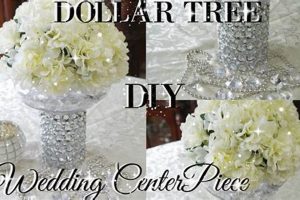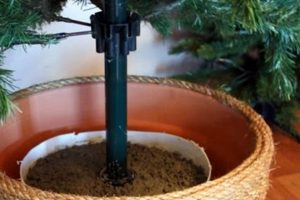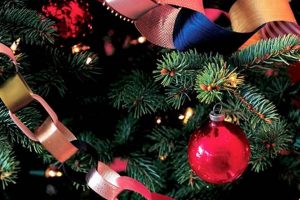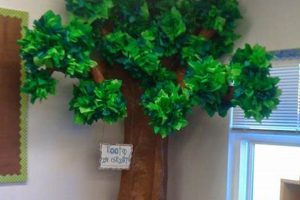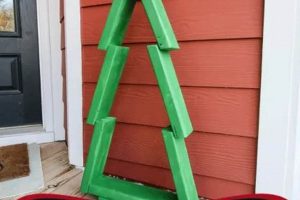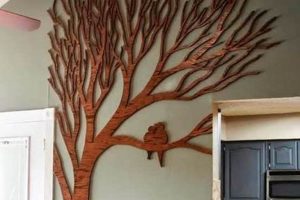The creation of artificial flowering cherry trees using readily available materials represents a popular crafting activity. These handcrafted simulations mimic the aesthetic appeal of real cherry blossom trees, offering a decorative element for homes, events, or as personalized gifts. Projects can range from simple constructions utilizing branches and paper flowers to more elaborate designs incorporating lighting and detailed floral arrangements.
The practice of crafting these decorative pieces provides an accessible avenue for artistic expression and home adornment. Their enduring nature offers a longer-lasting alternative to fresh flowers, reducing waste and providing a consistent visual appeal. Furthermore, the process can offer a therapeutic benefit through engagement with creative tasks, and a sense of accomplishment upon completion of the project.
Further sections will explore specific techniques and material options for constructing these items, outlining step-by-step instructions, providing visual examples, and highlighting variations in style and design to suit diverse preferences and skill levels. Different approaches to achieving a realistic or stylized final product will be presented.
Construction Guidance
The following guidelines aim to optimize the creation process and enhance the aesthetic result of the handcrafted tree.
Tip 1: Material Selection: The choice of materials profoundly impacts the final appearance. Natural branches, whether sourced or purchased, lend a more authentic texture. High-quality paper or fabric florals, in varying shades of pink and white, enhance the realism. Hot glue with low temperature can be used to fix the flowers safely without burn the paper flowers.
Tip 2: Branch Preparation: Before floral attachment, branches necessitate thorough cleaning and potential structural reinforcement. Washing removes debris and insects. Securing thinner branches to a sturdier base, such as a pre-cut wooden board or plaster-filled pot, prevents instability.
Tip 3: Floral Arrangement: Intentional placement of blossoms is critical. Mimic the natural density and distribution patterns of actual flowering trees. Concentrate blooms at branch tips, allowing for sparser coverage toward the base. Grouping flowers in clusters of varying sizes creates visual interest.
Tip 4: Adhesive Application: Exercise restraint in adhesive application. Excess glue detracts from the overall presentation. Employ a minimal amount of adhesive, targeting the central flower base for secure attachment to the branch.
Tip 5: Color Variation: Replicate the nuances of real cherry blossoms by incorporating subtle color variations. Utilize differing shades of pink, white, and even a touch of pale yellow within the floral arrangement to achieve greater depth and authenticity.
Tip 6: Secure Base: Ensure stability of the completed structure by anchoring the base appropriately. Weight the pot or base with stones or plaster. Consider using a wider base for larger, heavier arrangements to prevent tipping. Avoid glass based in case of accident.
Tip 7: Lighting Considerations: Incorporating miniature LED lights enhances the visual impact, particularly in low-light environments. Weaving the lights discreetly among the branches and blossoms creates a warm, inviting ambiance. Use battery powered leds for safety reason.
Adhering to these guidelines will improve the final product, ensuring a visually appealing and structurally sound decorative piece.
The subsequent section will address common challenges encountered during the building process and provide solutions for effective problem resolution.
1. Materials
The selection of materials forms the foundation of any handcrafted flowering cherry tree, directly influencing its aesthetic quality, structural integrity, and overall longevity. Material choices dictate the degree of realism achieved and the techniques employed during construction.
- Branch Substrate
The underlying structure of the tree, often composed of natural branches, artificial stems, or a combination thereof, significantly impacts the project’s authenticity. Natural branches, while demanding greater preparation, offer unparalleled realism. Artificial stems provide consistency in shape and size, simplifying the construction process.
- Floral Components
Petal construction ranges from paper and fabric to plastic and silk, each offering unique visual and tactile qualities. Paper offers affordability and versatility but may lack durability. Fabric and silk flowers exhibit superior realism and longevity, though typically at a higher cost. Plastic flowers offer greater durability and resistance to the elements.
- Adhesives
The choice of adhesive is critical for securing floral components to the branch substrate. Hot glue offers rapid adhesion but may be less forgiving and potentially damage delicate materials. Craft glues provide a slower setting time, allowing for adjustments, but may require additional support during the drying process.
- Base and Anchoring
The material used for the base impacts the tree’s stability and presentation. Ceramic pots offer aesthetic appeal and weight, while lightweight plastic pots require added ballast for stability. Plaster of Paris provides a sturdy anchoring medium for securing the branches within the base.
Careful consideration of these material aspects enables the crafting of a flowering cherry tree that is both visually appealing and structurally sound. The interplay of branch substrate, floral components, adhesives, and base materials determines the overall success of the handcrafted piece.
2. Structure
Structural integrity forms a critical aspect of any handcrafted flowering cherry tree, directly impacting its stability, durability, and overall aesthetic presentation. The arrangement of elements and their load-bearing capacity are paramount to the longevity of the design.
- Branch Support and Weight Distribution
The selection and arrangement of branches dictate the tree’s ability to support its floral embellishments. Strategically positioning thicker, sturdier branches at the base while distributing weight evenly across the structure prevents imbalances and potential collapse. An uneven weight distribution can lead to structural failure, especially with heavier floral components.
- Anchoring and Base Stability
A secure anchoring system within a stable base is essential for maintaining the upright position of the handcrafted tree. Utilizing a heavy base material, such as plaster or concrete, and ensuring a firm connection between the branches and the base prevents tipping and provides resistance to external forces. The base should be appropriately sized to proportionally support the dimensions of the upper structure.
- Connection Integrity and Adhesion
The strength and durability of the connections between the branches and the floral components are crucial for preventing detachment and maintaining the tree’s visual integrity. Employing appropriate adhesives and reinforcing connections with wire or other fasteners ensures a secure bond capable of withstanding handling and environmental factors. Weak adhesive bonds are a common cause of component failure.
- Overall Form and Balance
The final form and balance of the tree contribute not only to its aesthetic appeal but also to its structural stability. An asymmetrical or top-heavy design may compromise its ability to remain upright. Intentionally shaping and balancing the arrangement ensures a visually pleasing and structurally sound finished product. Attention to form prevents a disproportionate or unnatural appearance.
These structural considerations are fundamental to creating a handcrafted flowering cherry tree that is not only visually appealing but also durable and stable. Neglecting these aspects can lead to a fragile structure prone to damage and an ultimately unsatisfactory result, thus the need of extra consideration while building your own cherry blossom tree.
3. Aesthetics
Aesthetics, in the context of handcrafted flowering cherry trees, constitutes a critical factor influencing the perceived value and emotional impact of the finished product. The visual appeal, generated through careful selection and arrangement of materials, directly affects the degree to which the simulated tree evokes the beauty and serenity associated with real cherry blossoms. A well-executed aesthetic design enhances the decorative function of the piece, rendering it a focal point within its intended environment. In contrast, a disregard for aesthetic principles can result in a visually unappealing outcome, diminishing the desired effect.
The practical application of aesthetic principles extends beyond mere visual appeal. Accurate color palettes, realistic floral arrangements, and thoughtful branch shaping contribute to a convincing illusion. For example, employing varying shades of pink and white in the floral arrangement can mimic the natural color variations found in real cherry blossoms. Similarly, shaping the branches to emulate the graceful, arching form of mature cherry trees enhances the overall realism. Projects intending to serve as event centerpieces benefit directly from heightened aesthetic consideration, increasing the perceived sophistication and elegance of the occasion.
Ultimately, the integration of aesthetic considerations into the design and construction of simulated flowering cherry trees is paramount for achieving a successful result. Challenges inherent in replicating natural beauty can be overcome through diligent observation, meticulous material selection, and a commitment to artistic principles. An understanding of these concepts ensures that the finished product transcends a mere craft project, becoming a work of art capable of eliciting positive emotional responses and enhancing the surrounding environment, while the maker gets the joy of creation.
4. Technique
The successful fabrication of a simulated flowering cherry tree hinges significantly on the employed techniques. These methods dictate the efficiency of construction, the durability of the finished product, and the degree to which the artificial tree resembles its natural counterpart. Inadequate technique can lead to structural instability, unnatural aesthetics, and premature deterioration. For example, improper adhesive application can result in floral detachment, while imprecise branch shaping can undermine the overall illusion of realism. Thus, technique is not merely a procedural step but a critical determinant of outcome.
Specific examples of technique influencing the final product include the method of floral attachment. Securing each blossom individually with a small dab of hot glue yields a more natural distribution compared to adhering large clusters at once. Similarly, wrapping floral tape around the base of each branch before affixing flowers adds structural support and conceals the attachment point. Scaling techniques to the project’s size is also critical; smaller trees may benefit from intricate wiring, while larger structures require robust anchoring. Furthermore, precision cutting and shaping of floral materials enhance realism, particularly when replicating the subtle variations in natural blossoms.
The practical significance of understanding and applying effective techniques lies in the ability to create a visually compelling and structurally sound decorative piece. Skillful execution elevates the project from a simple craft to a credible imitation of nature, capable of enhancing interior spaces or serving as distinctive event decor. Conversely, neglecting technical proficiency can result in a flimsy and unattractive imitation, detracting from its intended purpose. Mastery of technique is therefore indispensable for anyone seeking to create a lasting and aesthetically pleasing artificial flowering cherry tree.
5. Scale
Scale, in the context of constructing simulated flowering cherry trees, exerts a profound influence on the overall aesthetic impact, structural requirements, and practical applications of the finished product. The dimensions of the crafted treeheight, width, and branch densitydirectly determine its suitability for various settings and the complexity of the construction process. A miniature tree, intended for a tabletop display, necessitates delicate craftsmanship and lightweight materials, whereas a life-sized replica requires a robust framework and more substantial components to maintain stability and visual fidelity.
The selection of scale must align with the intended purpose and environment of the tree. For instance, a small-scale recreation may serve as a detail in a miniature diorama, demanding meticulous replication of individual blossoms. Conversely, a larger-scale installation, designed as a stage prop or commercial decoration, prioritizes overall visual impact and may employ simplified floral arrangements. Accurate scaling also impacts material selection; oversized blossoms on a small tree or excessively delicate branches on a large tree compromise the realistic appearance. The available workspace and resources will dictate the feasible scale of a project.
In summary, scale serves as a foundational design parameter, governing both the technical and aesthetic considerations in creating artificial flowering cherry trees. A clear understanding of proportional relationships and dimensional constraints is essential for achieving a visually compelling and structurally sound result that effectively fulfills its intended purpose, be it a subtle desktop accent or a grand-scale environmental installation. Disregarding the impact of scale can result in a product that appears disproportionate, fragile, or simply unsuited to its intended setting.
6. Durability
The longevity of a handcrafted flowering cherry tree directly correlates with the materials employed and the construction techniques utilized. A project lacking durability yields a short-lived decorative item, negating the investment of time and resources. The causes of diminished lifespan often stem from substandard materials susceptible to degradation or assembly methods that compromise structural integrity. The importance of durability manifests in the ability of the piece to withstand environmental factors, such as humidity and temperature fluctuations, as well as the rigors of handling and storage.
For example, utilizing paper-based floral components without protective coatings renders them vulnerable to moisture damage, resulting in discoloration and disintegration. Similarly, using weak adhesives or inadequate support structures can lead to detachment of branches and blossoms over time. Incorporating ultraviolet light inhibitors within the floral material minimizes color fading from sun exposure. Selecting rot-resistant branch materials, when natural components are incorporated, extends the lifespan of the underlying structure. Application of a sealant will extend the durability of the paper flower.
In summary, the pursuit of a lasting handcrafted flowering cherry tree necessitates careful consideration of durability. Choosing robust materials, employing sound construction techniques, and incorporating protective measures against environmental factors are paramount. The practical significance of this understanding lies in the creation of a decorative item that provides enduring aesthetic pleasure, thereby justifying the effort invested in its fabrication. By building with durability in mind, ensures that the final product will last for a long time.
7. Placement
Placement, in the context of handcrafted flowering cherry trees, represents a pivotal determinant of the piece’s visual impact and its integration within a given environment. The location chosen directly influences how the artificial tree is perceived and the extent to which it enhances the surrounding space. A poorly considered location can diminish the tree’s aesthetic qualities and disrupt the overall harmony of the setting. Conversely, a well-selected placement can amplify its visual appeal and create a focal point, effectively transforming the ambiance of the room or event.
The effect of placement manifests in various scenarios. For example, a small-scale cherry tree placed on a cluttered shelf may be visually lost, failing to capture attention or contribute to the decor. Conversely, the same tree positioned on a minimalist table against a neutral backdrop becomes a striking accent piece, drawing the eye and adding a touch of elegance. A larger-scale tree, strategically positioned near a window, can create the illusion of an outdoor scene, blurring the boundaries between interior and exterior spaces. The impact also considers lighting; a tree placed in direct sunlight might suffer color fading over time, while one positioned in a dimly lit corner may require artificial illumination to highlight its features. Placement, therefore, is inextricably linked to the tree’s aesthetic and functional success.
In summary, mindful placement constitutes an indispensable aspect of incorporating handcrafted flowering cherry trees into any setting. Factors to consider include visibility, background context, lighting conditions, and the intended focal point within the space. Overlooking the importance of placement can undermine the effort invested in crafting the tree itself, resulting in a diminished aesthetic impact. Effective placement elevates the artificial tree from a mere decorative object to a carefully integrated element of its surroundings, enhancing its visual appeal and contributing to the overall ambiance, giving you a wonderful and beautiful scene.
Frequently Asked Questions
The following addresses frequently encountered inquiries regarding the creation of artificial flowering cherry trees. The information aims to clarify common points of confusion and offer guidance on best practices.
Question 1: What is the optimal adhesive for attaching floral components to the branch structure?
The selection of adhesive depends primarily on the materials involved. Hot glue offers rapid adhesion suitable for many combinations. However, for delicate materials such as paper or silk, craft glues or floral adhesives provide a gentler alternative, minimizing the risk of damage.
Question 2: How can structural stability be ensured, particularly for larger-scale projects?
Structural stability is achieved through a combination of factors: a robust base, a sturdy branch framework, and secure connections. Utilizing a weighted base material, such as plaster or concrete, and reinforcing branch joints with wire or epoxy enhances overall stability.
Question 3: What are the best methods for replicating the natural color variations found in real cherry blossoms?
Achieving realistic color variation involves employing multiple shades of pink, white, and pale yellow within the floral arrangement. Layering different tones and subtly blending colors creates depth and visual interest, mimicking the nuances of natural blossoms.
Question 4: How can the artificial tree be protected from environmental factors, such as sunlight and humidity?
Protecting the tree from environmental damage involves several measures. Applying a UV-resistant coating to the floral components minimizes color fading from sunlight exposure. Selecting moisture-resistant materials and avoiding placement in humid environments prevents deterioration from moisture absorption.
Question 5: What is the recommended approach for shaping the branches to achieve a natural aesthetic?
Shaping the branches involves careful observation of real cherry trees. Mimicking the graceful, arching form of natural branches requires strategic bending and pruning. Avoid rigid, symmetrical arrangements, opting instead for a more organic and asymmetrical silhouette.
Question 6: Is it feasible to incorporate lighting into the artificial tree, and if so, what are the safety considerations?
The integration of lighting is indeed feasible and can enhance the visual impact. Employing low-voltage LED lights minimizes the risk of overheating and electrical hazards. Ensure proper insulation of wiring and utilize battery-operated lights to eliminate the need for external power sources, enhancing safety.
These answers provide a foundation for navigating the construction process and addressing common challenges. Careful attention to these factors will increase the likelihood of a successful and aesthetically pleasing outcome.
The subsequent section explores advanced techniques and alternative design approaches for further customization and refinement.
DIY Cherry Blossom Tree
The preceding discourse has explored the multifaceted aspects of the diy cherry blossom tree, encompassing materials, structure, aesthetics, technique, scale, durability, and placement. A comprehensive understanding of these elements is essential for the successful creation of a simulated flowering cherry tree that is both visually compelling and structurally sound. The presented guidelines and considerations serve as a framework for navigating the intricacies of this craft, offering a foundation for both novice and experienced artisans.
The ability to replicate the beauty of nature through handcrafted means is a testament to human creativity and ingenuity. Continued exploration and refinement of these techniques will undoubtedly yield further advancements in the art of creating artificial flora, enhancing the possibilities for decorative expression and environmental enhancement. The diligent application of the principles outlined herein will empower individuals to craft enduring symbols of spring’s ephemeral beauty, regardless of geographical constraints or seasonal limitations.


